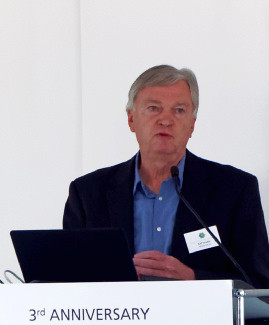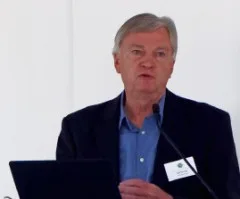The 3IT started as a 3D research institute three years ago, but last year changed its name to the Innovation Center for Immersive Imaging Technology, as 3D moved out of fashion. The change meant that growth has been able to be continuous since the change, which might not have happened if 3D was still in the name. The centre is attached to the Heinrich Hertz Institute in Berlin which is part of the Fraunhofer organisation. The “Scenic Centre” of the 3IT, where many activities take place, will become the “Smart Data” centre in the future.
As it did last year, the organisation took advantage of the fact that some partners were in town for IFA to hold a meeting to update on its progress.
The first speaker was Dr. Andreas Gördeler from the German government and he said that the government strongly supports the centre. Although the centre was started to support 3D in films, the technology is now being developed for engineering, medical and other applications. There is continuing growth in all 3D segments, with growth of more than 10% per annum and is expected to grow to more than €30 billion by 2020. Bitkom, the German trade association, has also reported that 3D technology will have an influence on the whole economy.
The government is looking at new programmes that could help to integrate 3D technologies into industrial applications and this will include additive manufacturing, but will also includes optics, stereoscopy and image processing. Gördeler said that Albert Einstein said that fantasy is more important than knowledge because knowledge is limited.
 Ralf Schäfer is chair of the steering group of 3IT and head of HHIKathleen Schröter runs the 3IT Center and she introduced Ralf Schäfer, a video specialist and head of the Fraunhofer HHI who is chair of the steering committee. He said that the centre had around 50 partners to start and still has the same, but some have left, some have joined. The group will grow because of changes in scope. (Schaefer made some interesting comments when he was on the IHS panel on UltraHD, later in the show – Panel Reviews UltraHD Future).
Ralf Schäfer is chair of the steering group of 3IT and head of HHIKathleen Schröter runs the 3IT Center and she introduced Ralf Schäfer, a video specialist and head of the Fraunhofer HHI who is chair of the steering committee. He said that the centre had around 50 partners to start and still has the same, but some have left, some have joined. The group will grow because of changes in scope. (Schaefer made some interesting comments when he was on the IHS panel on UltraHD, later in the show – Panel Reviews UltraHD Future).
In the last year, there have been 10 workshops in the centre, more than 1,000 visitors and 12 lots of 3D content shooting. Originally, there were a number of working groups, but it was hard to keep them going without funding, so the strategy was to develop concrete projects.
The first group started a project in 3D quality assessment and then a 3D production project funded by the government.
Schäfer said that stereoscopy is tricky and has to be of high quality and this needs measurement. It’s not so important for entertainment but may be critical for medical applications, for example.
The centre is working on quality by measuring brain activity to try to map this to 3D quality and this is an on-going project. Another project was about 3D production quality control. A third project was funded by Disney to look at a new camera system for 3D capture and a prototype was developed. A lot of software needed to be developed for applications such as Nuke and Mistika and this is being developed now. 3DInMed is a medical project.

